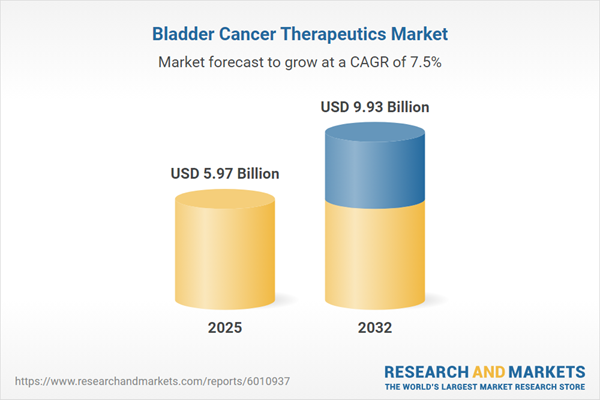Speak directly to the analyst to clarify any post sales queries you may have.
Senior executives navigating the bladder cancer therapeutics market encounter complex and shifting dynamics requiring evidence-based, forward-thinking decision-making. This analysis distills critical data and strategic guidance to equip business leaders for ongoing transformation across clinical, regulatory, and technological frontiers.
Market Snapshot: Bladder Cancer Therapeutics Market Size and Growth
The global bladder cancer therapeutics market is currently valued at USD 5.56 billion, with projections indicating growth to USD 5.97 billion by 2025 and USD 9.93 billion by 2032, representing a CAGR of 7.52%. Industry expansion is supported by advances in clinical trial outcomes, evolving regulatory approaches, and increasing adoption of patient-oriented care frameworks. As companies adapt commercial models and reinforce supply chains, the introduction of advanced precision therapies drives regional responsiveness, enabling solutions tailored for diverse global stakeholder needs.
Scope & Segmentation of the Bladder Cancer Therapeutics Market
This report gives an in-depth market breakdown, empowering senior decision-makers to shape investment, development, and expansion strategies aligned to emerging challenges and opportunities.
- Therapeutic Approaches: Includes platinum-based and non-platinum chemotherapy, combination regimens, immune checkpoint inhibitors, cellular and cytokine therapies, and gene therapies. Organizations can use insights on oncolytic viruses, nanomedicines, photodynamic therapy, and molecular-targeted agents (e.g., EGFR, FGFR, HER2 inhibitors) to inform R&D priorities and portfolio investments.
- Treatment Stages: Covers metastatic, muscle-invasive, and non-muscle-invasive cancers. Detailed analysis of these categories supports targeted clinical strategies and resource alignment throughout the disease continuum.
- Treatment Lines: First-line, second-line, and third-line therapies are mapped to optimize therapy sequencing and access strategies, enhancing resource planning and operational agility as standards of care shift.
- Administration Routes: Reviews intravenous, intravesical, and oral delivery models. Understanding route preferences assists with optimizing compliance, care settings, and infrastructure utilization.
- Distribution Channels: Dissects supply chain strategy across hospital, retail pharmacy, and online channels. This segmentation underpins market access approaches and distribution solutions aligned to local demand and regulatory climates.
- End Users: Profiles the roles of hospitals, specialty clinics, and home care providers. The report highlights the increasing relevance of decentralized and patient-centric delivery models for market penetration.
- Regional Markets: Assesses the Americas, Europe, Middle East & Africa, and Asia-Pacific regions. Analysis focuses on regulatory diversity, infrastructure maturity, and the adoption of innovative technologies, offering guidance on geographic prioritization and tailored go-to-market models.
- Key Companies: Features Merck & Co., F. Hoffmann-La Roche, and AstraZeneca, outlining research focus, partnership trends, and market stance for effective competitor benchmarking and alliance planning.
Key Takeaways for Senior Decision-Makers
- Personalized and immunotherapy advancements allow differentiation in product offerings and support adaptable treatment pathways, empowering organizations to respond swiftly to innovative care paradigms.
- Real-world evidence integration and adaptive clinical model adoption enhance regulatory relationships and accelerate time-to-market for new therapeutic entrants.
- Collaborations between pharmaceutical and biotechnology firms drive solution reach and address complex healthcare delivery needs, fostering multidisciplinary advancements.
- Region-specific strategies remain essential due to contrasts in health infrastructure and policy, requiring organizations to deploy agile, resource-efficient go-to-market initiatives.
- Growing investment in digital capabilities and workforce development sustains operational efficiency and nurtures readiness for new treatment methodologies.
- Ongoing vigilance around reimbursement and regulatory developments secures patient access and underpins robust organizational resilience amidst evolving compliance expectations.
Tariff Impact: U.S. Policy Changes and Supply Chain Response
Expected tariff changes in the United States for 2025 introduce added complexity into global supply chains for bladder cancer therapeutics. In response, organizations are bolstering supplier engagement, upgrading logistics infrastructure, and refining contractual terms to protect distribution continuity. Strategic pricing adjustments and creative distribution approaches are recommended to minimize disruption and sustain reliable product availability as regulatory changes take effect.
Methodology & Data Sources
The report’s findings are grounded in peer-reviewed research, expert interviews, and senior executive feedback, strengthened through rigorous secondary validation and scenario-based modeling. This comprehensive approach supports reliable forecasting and up-to-date market intelligence.
Why This Report Matters
- Enables senior leaders to anticipate regulatory changes and respond to supply chain complexities, supporting business continuity and risk mitigation.
- Facilitates data-driven investment and resource allocation decisions, equipping teams to capitalize on shifting market requirements.
- Delivers actionable insights for strengthening operational performance and navigating evolving industry changes with confidence.
Conclusion
This analysis provides senior business leaders with an essential foundation for navigating the accelerating bladder cancer therapeutics landscape. Use the insights within to drive resilient, well-informed strategic decisions.
Additional Product Information:
- Purchase of this report includes 1 year online access with quarterly updates.
- This report can be updated on request. Please contact our Customer Experience team using the Ask a Question widget on our website.
Table of Contents
3. Executive Summary
4. Market Overview
7. Cumulative Impact of Artificial Intelligence 2025
Companies Mentioned
The companies profiled in this Bladder Cancer Therapeutics market report include:- Merck & Co., Inc.
- F. Hoffmann-La Roche Ltd.
- AstraZeneca PLC
- Bristol-Myers Squibb Company
- Pfizer Inc.
- Johnson & Johnson
- Eisai Co., Ltd.
- Astellas Pharma Inc.
- Seagen Inc.
- Sesen Bio, Inc.
Table Information
| Report Attribute | Details |
|---|---|
| No. of Pages | 198 |
| Published | October 2025 |
| Forecast Period | 2025 - 2032 |
| Estimated Market Value ( USD | $ 5.97 Billion |
| Forecasted Market Value ( USD | $ 9.93 Billion |
| Compound Annual Growth Rate | 7.5% |
| Regions Covered | Global |
| No. of Companies Mentioned | 11 |









